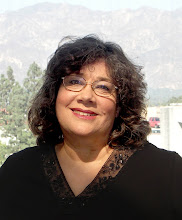Chris Brandow wins with his 4:02 p.m. Tuesday guess "Busch gardens, maintaining the gnome decorations down in the arroyo."
In the 1933 photo above, an artist touches up sculptures of gnomes at the 30-acre Busch Gardens in Pasadena's Arroyo Seco.
Gnomes were featured at several locations on the property, including the Snow White exhibit shown in this colorized postcard...
...and gnomes fishing at the Mystic Hut:
Busch Gardens included 14 miles of pathways, 100,000 plants and shrubs, rare birds and more than 100 brightly painted sculptures imported from Germany, including Little Red Riding Hood.
But the sheer scope and majesty of Busch Gardens was the ultimate draw, making it the most popular attraction in Southern California.
Adolphus passed away in 1913 in Germany, where he and Lilly had a vacation villa. In the mid-1930s the property was subdivided into four parcels and sold to developers.
There are nice residential neighborhoods there now, with a few remnants of Busch Gardens infrastructure, including this portion of the original entrance (note the street name):
There's so much more to the Busch Gardens story than can be told here on my little blog, so I'll point you in the direction of additional information.
The Pasadena Museum of History hosted a very important exhibition in 2005 commemorating the 100th anniversary of the opening of Busch Gardens.
A series of very good descriptions of Busch Gardens and dozens of photo images can also be found here.
Pasadena Daily Photo blogger Petrea has posted about remnants of Busch Gardens, such as this one.
Many thanks to Pasadena Public Library and Pasadena Museum of History.












8 comments:
It's true, the history of Busch Gardens is as vast as the territory it once covered. Thanks for the links, Ann.
Congrats to Chris. And Ditto.
In reading "Last Call," a terrific history of prohibition, the Busch family comes up very often.
They were vilified in the lead-up to WWI because they spent a lot of time in Germany and supported the German cause during the war.
Anti-immigrant sentiment, stemming mostly from white, midwestern Protestants, was a big part of the prohibitionist cause. Very interesting!
Thanks for your post, Ann.
This is an amazing amount of information. You do this every day? Where have I been?
John, Mystery History photos are posted on Tuesdays and the big reveals are on Thursdays.
The artist in the first picture is Helen Burke, who was hired by Busch Gardens in 1935 to restore the gnomes and other statuary in the gardens. In 1937 she and a then 17 year old Don Winton created reproductions of the gnomes along with small animal figurines that were sold from the gift shop located in the Rosy Wall Cottage at Busch Gardens. Don went on to co-found Twin Winton Ceramics with his twin brother Ross and also freelance designed and sculpted for other major companies, including Disney. He designed Disney's iconic Mickey Mouse telephone and the Emmy Award, to name just two pieces that would be familiar to most people.
Love the additional history, Brian.
The Pasadena Museum of History is doing an exhibit on Pasadena pottery companies. Burke-Winton will be one of the featured companies and I was wondering how I could get a copy of the picture of Helen Burke touching up the gnomes?
Post a Comment